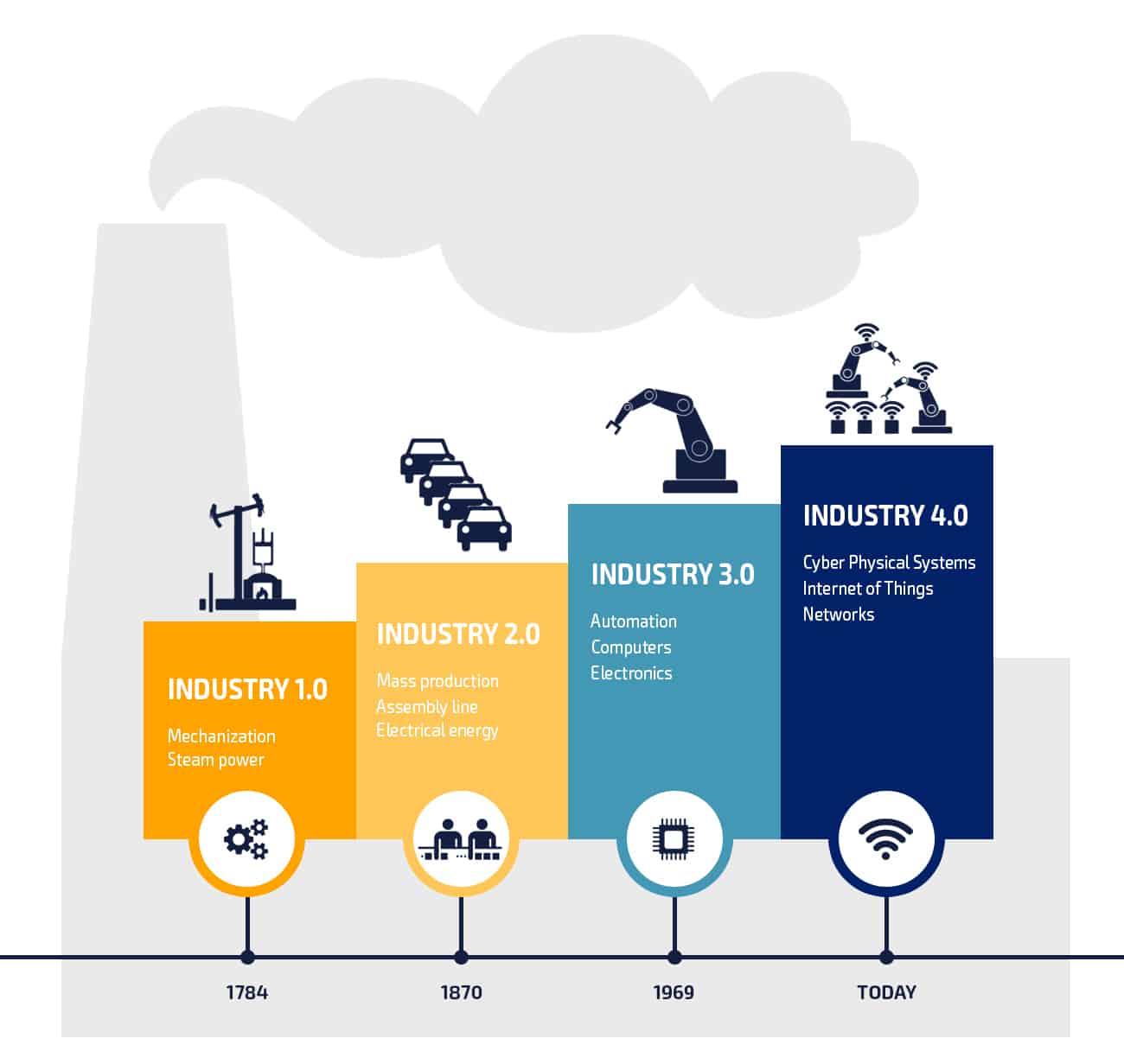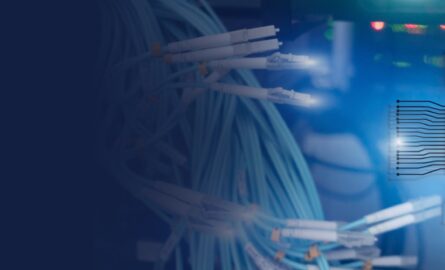The digital invasion
Hollywood movies with humans and machines collaborating in the workplace of the future are starting to become a reality. According to the researches, in 2008 the number of devices connected to the global network exceeded the number of the Earth’s population, marking a transition from the Internet of People to the Internet of Things.
This new wave of connectivity is going beyond consumer gadgets. IoT empowers various industries by making their processes automated and smarter, triggering another step of industrial revolution. With the first one being the introduction of the water and steam engines at the end of the 18th century, the second bringing electrically-powered mass production in the early 1900s, and the third establishing automation of the manufacturing process during the 1970’s, the last 30 years brought the next industrial revolution driving the movement to the visionary Industry 4.0.

Connectivity as a driving force
Each revolution is about making a change. The powerful impulse for the fourth step of industrial transformation was the concept of interoperability – the ability of devices, sensors and people to connect and “talk” to each other, creating a smart network.
As an intersection of mobility, cloud computing and big data analytics, the IoT is a game changer for many industries, enabling them to embed connectivity into physical objects. This leads to new operational efficiencies by minimizing human influence on different industrial processes, as well as to new business intelligence due to information support for decision making empowered by valuable data. With digital infrastructure constantly evolving, IoT is covering almost all domains, spanning a number of previously unimagined applications.
According to PwC research, over 30% of industrial businesses are already benefiting from an advanced level of digitalization achieving up to 10% of additional revenue, and this percentage is expected to more than double by the end of the decade [1]. The IoT enablement is helping companies to improve productivity, reduce operating costs and enhance worker safety. For instance, BP is implementing wearable devices to monitor the health of their employees, suggesting that by 2020 wearables will be widely used in oil and gas sector to sense dangerous chemicals and notify workers in case of emergency [2].
However, for all the importance of the technology, the implementation of the IoT requires organizational changes as well. A connected product enables new services, which means that existing business models should also evolve.
How the industrial IoT is transforming businesses
As an example, let us consider global industrial equipment manufacturers. Previously their products were delivered to a vendor, who in turn sold them to the end-user. In this model, the vendor acted as a mediator between the user and the manufacturer, and the latter was notified only when something went wrong. In addition, the manufacturer knew very little of how the equipment was performing and how it was being used once it left their assembly line.
Now, with sensor-enabled equipment delivering regular telemetry data directly to the manufacturer, they become no longer simply the producer, but also a provider of new data-driven services. This allows the manufacturer to reimagine the business potential of their product and offer their customers new options such as remote management or predictive maintenance. The possibilities are endless!

Hands-On Exploration of SONiC in Optical Transport Networks
Learn why the launch of SONiC-OTN extends SONiC's capabilities into the domain of Optical Transport Networks, offering a comprehensive solution for managing both optical and packet-based networks on a unified platform.
Industrial IoT applications
IoT-enablement has become a business priority for many companies. Wondering how to apply it to your business? The following use cases can give you some ideas.
Predictive maintenance. Manufacturers are constantly looking for ways to minimize industrial equipment downtime and avoid unscheduled outages. Machines are inclined to breaking during the production process and the repairs can be not only time-consuming, but also very expensive. Therefore, being able to predict when maintenance work is needed can greatly reduce maintenance costs.
This challenge can be addressed by putting special sensors on industrial equipment. These sensors generate and capture equipment data which is then processed and analyzed. The analysis makes it possible to identify problems in the behavior or state of equipment and enables accurate prediction on when it is about to break, so that maintenance schedules can be planned accordingly.
Condition monitoring. This is a new method of ensuring asset availability based on continuous monitoring of its data to detect wear and reduce maintenance costs as only worn-out details require replacing.
This approach is commonly applied to mission critical industrial equipment used to drill oil and gas wells, which needs to be monitored 24/7 in order to get the earliest possible warning on deteriorating conditions. Without a “smart” system, a company would have to send someone out to control each well, and there can be thousands of them spread across a region. With the power of the IoT this can be done remotely: data from sensors can precisely pinpoint anomalies in the drilling process, help to avoid breakdowns and save petroleum companies billions of dollars per year. According to Accenture’s survey, 62% of oil and gas executives worldwide say they will invest in IoT even more than they currently do [3].
Smart metering. Energy and utilities industry is also on its way to the IoT adoption. The most common applications of the IoT within the industry are related to smart meter technology with the help of which both energy producers and consumers can measure and proactively manage gas and electric energy consumption in near real-time. The intelligent meters enable the development of a remote-energy management system helping energy consumers to decrease the amount of the used energy as well as reduce their electricity bills.
As for utility companies, they are now able to not only measure total energy consumption, but also acquire data from smart meters on where and when exactly the energy was consumed. Based on this data, they can change prices for energy consumption depending on times of the day. This approach allows them to match energy consumption and its generation by encouraging consumers to use electricity during off-peak hours, when the rate is considerably cheaper.
Smart metering is widely applied by different states as part of a national energy reduction plan. For example, by the end of 2016 39% of Dutch households had smart meters installed and the government aims to reach 80% by 2020 [4].
Making the most of the sensory data
The Internet of Things is definitely one of the most innovative technologies of the 21st century and its adoption is the core business strategy for many organizations within various industries. However, the IoT-enablement is not only about simply putting sensors on every piece of equipment, it is also pretty much about the money. The main challenge for companies is to proactively look at the data streams that could be generated from their devices as well as their potential value for their own and their customers’ businesses.




